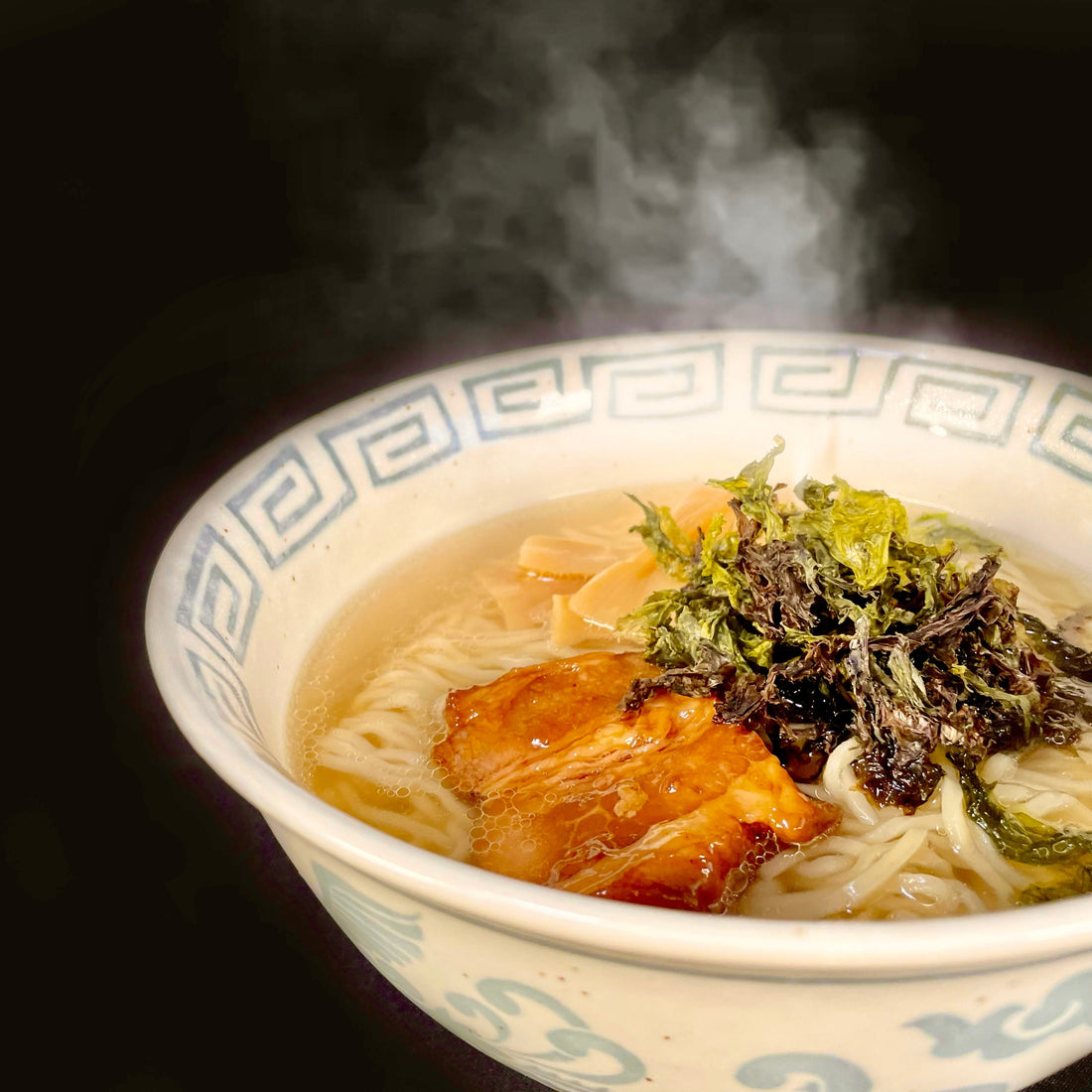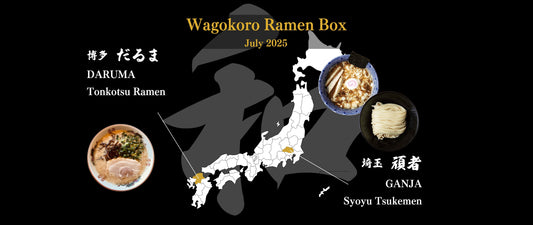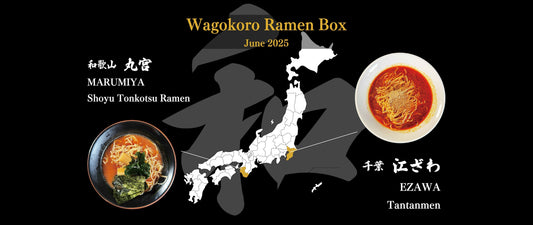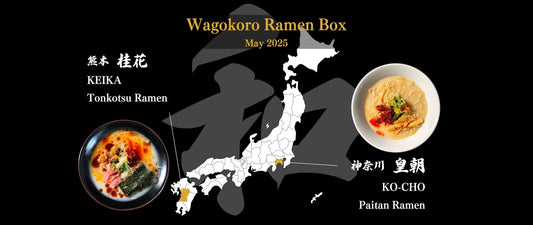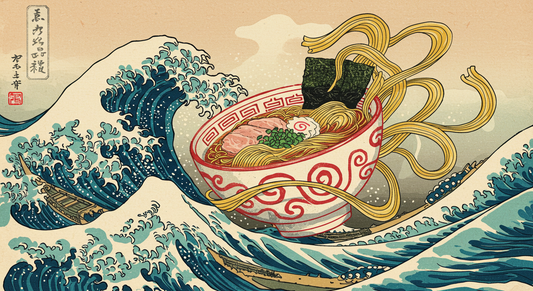Shio ramen is one of the popular salt-flavored noodle soups in Japan. It is known for its savory light taste.
In this article, we will explain more about what exactly shio ramen is.
What you will learn:
- Origins of shio ramen
- The taste of shio ramen
- Difference with other ramen etc.
Click here to enjoy your authentic ramen conveniently
What Is Shio Ramen?

Shio (pronounced as ‘shee-oh”) literally means “salt” in Japanese.
It’s the ramen that originated in Hakodate City in Hokkaido.
Here are some overviews of the history and what it tastes like.
History of Shio Ramen

The history of shio ramen is rather vague compared to miso and shoyu ramen.
It said that originated in Hakodate-city through Southern Chinese people.
In the late Edo era, Hakodate City opened a port and many Southern Chinese people started immigrating.
They brought a dish called Qing Tang Soup(清湯スープ) which has a clear salt taste.
The first shio ramen roots were invented in 1884, when the Guang Zhou Chef opened a restaurant called, Yo-wa ken (養和軒).
As the chef worked in the British Consulate, the store has a style of a European-style cafeteria. At that time, the dish was called “nankin soba”.
It’s still a mystery when it’s called shio ramen, but it is perhaps called differently after “ramen” was found in Tokyo.
As ramen get popular in Japan, miso ramen and tonkotsu ramen became popular. In 2000, finally, shio ramen became a trend in Japan and people started to open ramen stores in different prefectures.
History:
1780-1850 Southern Chinese started living in Hakodate-city, Hokkaido
1884 Yo-wa ken opened in Hakodate-city
1910 First ramen store, rairaiken opened in Asakusa, Tokyo
2000 Shio ramen becomes popular across Japan
What Does it Taste Like?

Shio ramen has a strong salt umami taste.
Japan has shoyu, miso, and shio (salt) as the 3 main sauces for ramen called tare.
They will blend it with the broth (dashi) taken from pork, chicken, kelp, or any other ingredients before serving.
For shio ramen, it’s common to add salt, cooking sake, mirin, sugar, and soy sauce to make the shio-dare. This gives a clean, sweet, and savory sauce that is addictive.
However, as shio ramen is one of the delicate ramen that highly depends on the chef's skills, some chefs prefer to keep the taste simple with just dashi and salt.
It’s also common to match seafood or shellfish dashi with shio ramen.
What Is the Difference With Other Ramen?

The main difference is what it’s used in the tare.
Shio ramen is more refreshing and delicate compared to other ramen.
It’s recommended to someone who likes to enjoy the taste of real ingredients, simple taste, and light texture.
Shoyu ramen usually uses soy sauce as the base, and it also has a refreshing taste just like shio ramen.
However, it’s more common to use chicken broth than seafood broth, so it has a different flavor.
If you prefer a thicker taste, you should try miso ramen or tonkotsu ramen.
It usually uses pork bone as a dashi, so it has a richer and mellower texture
Noodle That Goes Well With Shio Ramen

Shio ramen usually goes well with any kind of noodles because of its simplicity.
If you want to enjoy the taste of the soup itself, you can try straight noodles that are thinner. It entangles the soup the most.
If you want to enjoy the taste of the noodles, you can try the curly and thick noodles.
Recommended Toppings
Shio ramen also goes well with standard toppings such as soft-boiled eggs, menma, or chashu.
Here are also the 3 toppings you may want to try specifically for shio ramen.
- Wanton
Meat or prawned stuffed wanton is widely seen in Chinese style noodles. The texture of the wanton skin goes well with the clear and light soup.
- Meat/fish ball
You can enjoy the umami of meat and/or fish balls while enjoying the pure shio ramen taste.
- Fish meat
Since shio ramen is usually made with seafood, it goes well with the sliced flaky white fish.
Recommended Shio Ramen Store
Here are some of the Shio ramen that you might want to try in Japan.
Recommended stores:
- Hirugao(ひるがお)
- Tsukimiken(月見軒)
- Ichigen(一幻)
Hirugao(ひるがお)
It's been six years since the last time I ate this exact bowl 🤩
— Chiko™ (@fschiko_) September 25, 2022
(Hirugao shio ramen) pic.twitter.com/W8GPWgdoN3
Hirugao is a time-limited shio ramen store that is open only at lunchtime. This store usually operates as Ramen Setagaya, the “Best of New York, Restaurant section”
It uses 2 types of dried sardines, dried shiitake, kelp, and bonito flakes for its dashi, which brings a refined and delicate taste.
There are Ramen Setagaya shops overseas, but Hirugao is only in Japan.
You can check their ramen box here to enjoy out of Japan
Tsukimiken(月見軒)
Tsukimiken is a restaurant owned by an owner of kappo (Japanese course cuisine) restaurant, Misuji(三筋)in Sapporo-city, Hokkaido.
The store opened in 1958, and when the owner wanted to try out something more accessible to the masses, he started Tsukimiken.
Shio ramen in Tsukimiken has a deep taste that has never changed since they started the business.
The ramen is available in Sapporo and Tokyo.
Ichigen(一幻)
2杯とも完食
— On Takahashi (高橋温) (@OnTakahashi) September 19, 2022
えびそば一幻は僕が一番好きなラーメンで、北海道に行くより台湾や香港のほうがLCC安かった時は海外支店行ってまで食べてた 😂
If you're interested in shrimp-based ramen, you gotta go to Ebisoba Ichigen. You won't regret it. Best in the biz. pic.twitter.com/myhAaMKTVF
Ichigen is a ramen that originated from Hokkaido. It uses the heads of sweet shrimp to make umami dashi, shrimp oil, and shrimp red ginger for their ramen.
You can enjoy the Hokkaido sea breeze from their specialty shio ramen.
Its main store is in Hokkaido, but it also has branches in Tokyo, Taiwan, and Hong Kong.
You can check their ramen box from here
Let’s Cook and Eat Shio Ramen!
There’s a way to enjoy the descent shio ramen easily at home.
You will just have to boil the noodles, add water soup, and the noodle in the bowl just like an instant noodle.
Click here to check the ramen gift box you can order online!
Q&A
Here are some questions that you might be wondering.
- What is the difference with shoyu ramen?
The main difference is the tare they use. Shio ramen uses tare which is a salt base, and shoyu ramen uses soy sauce base.
Also, shio ramen usually uses seafood stock while shoyu ramen uses chicken stock. The taste is both refreshing and distinctive.
- Which ramen is the saltiest?
It highly depends on how each ramen is cooked.
According to the comparison list by the Japan Instant Food Industry Association, most ramen has about the same salt content regardless of the taste.
- What is Wagokoro Japan Gift?
Wagokoro Japan Gift is a Japanese online shop that offers fresh and nice ramen boxes overseas.
It provides popular Japanese ramen on all shio, miso, shoyu, and tonkotsu ramen.
With the ramen box, you can enjoy the authentic taste even if you’re out of Japan.

